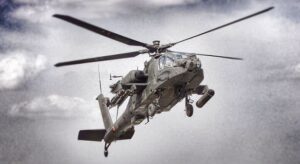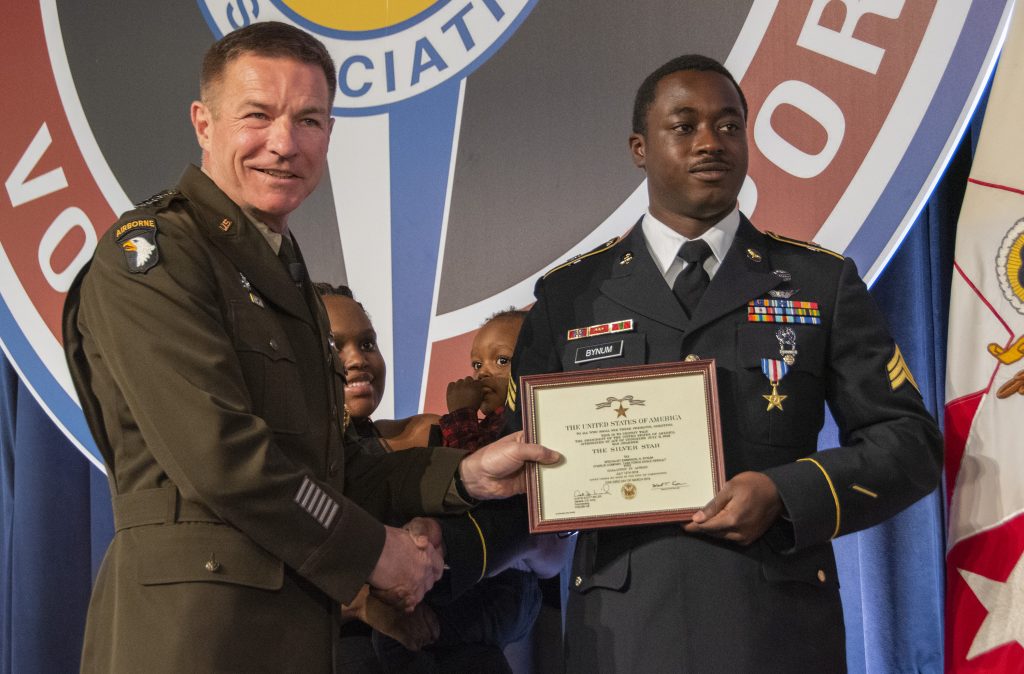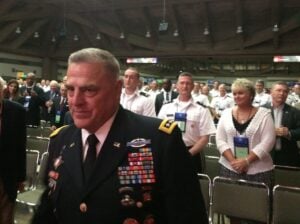National Guard Will Get Black Hawk Replacement Early: Army Vice-Chief
Posted on
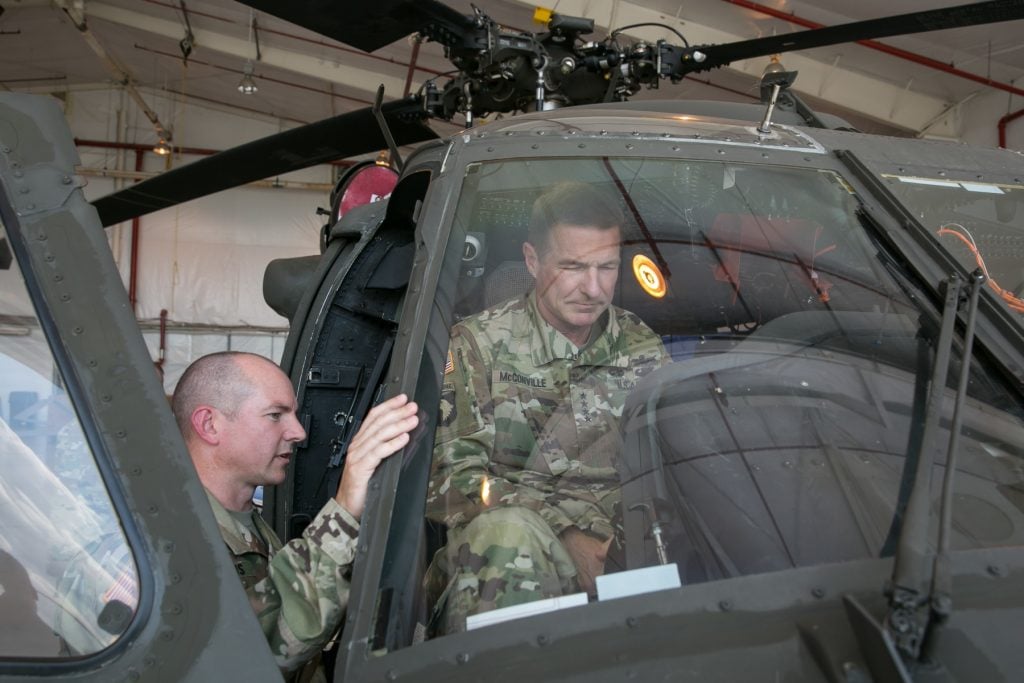
Gen. James McConville checks out the upgraded cockpit of the new UH-60V “Victor” model, which will be mainly used by the National Guard.
NASVHILLE: “High priority” National Guard units will get the high-speed, long-range replacement for the UH-60 Black Hawk at about the same time as elite active-duty formations, the Army’s No. 2 officer promised this week. That would modernize at least some Guard units ahead of the majority of the regular Army. It’s a dramatic turnaround from three years ago, when Army leaders and the Guard community were bitterly and publicly at odds over taking helicopters out of the Guard.
“As far the Future Long Range Assault Aircraft, we see that being fielded initially to have those units that have forced- or early-entry type missions, like the 101st Airborne Division, the 160th Special Operations Aviation Regiment, the 82nd Airborne Division,” Gen. James McConville told the Army Aviation Association of America conference here, naming three of the Army’s most elite and storied formations. “We also see them being fielded to the National Guard in units with a high priority early on as we go forward.”
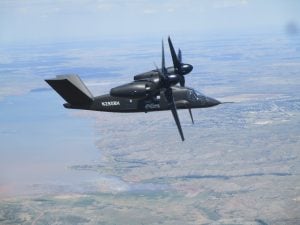
Bell V-280 Valor tiltrotor in level flight with rotors facing forward. The V-280 is widely considered the leading candidate for the Future Long-Range Assault Aircraft (FLRAA)
Not Just FLRAA
It’s not just FLRAA that’ll go to the Guard, McConville told reporters after his remarks to the conference. The Army’s working on lots of new technologies and organizations for future Multi-Domain Operations, he said, and “we’re going to put some of these new capabilities into the Guard up front, which is a little different than we have done in the past.”
There’s already a vigorous program to modernize Guard aviation, the assistant director of the Army Guard told the conference. All the Guard’s Chinook heavy-lift helicopters have been upgraded to the CH-47F Block I standard, Brig. Gen. J. Ray Davis said. The Guard’s UH-60L “Lima” Black Hawks will be upgraded to the UH-60V “Victor” model, which has come under some criticism but which Davis said is actually “better than the [regular Army’s UH-60M] ‘Mikes’ in a lot of ways.” And the Guard will begin replacing its AH-64D Apaches with the latest AH-64E model in 2022, with all four Guard Apache battalions upgraded by the end of 2026.
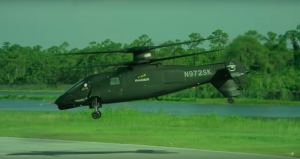
Sikorsky’s S-97 Raider, a leading candidate for the Future Attack Reconnaissance Aircraft, shows off its agility.
But those are all new models of old aircraft that entered service in the Cold War. FLRAA, by contrast, will be an all-new design — not even a conventional helicopter, but either a compound helicopter or a tiltrotor — developed under the Future Vertical Lift program. What about giving the Guard early access to the Army’s other new FVL aircraft, the Future Armed Reconnaissance Aircraft (FARA)?
“We’ll take a look at that,” McConville said.
Why different answers on different aircraft? McConville didn’t say. The simplest explanation is that the Guard already has plenty of UH-60 Black Hawks, which is the aircraft FLRAA would replace in assault, transport, cargo, and medevac missions. The Guard doesn’t currently have scout helicopter units, which is where FARA would go.
Strictly speaking, the regular Army doesn’t have any scout helicopters either. Both active and Guard units retired their aging OH-58D Kiowa Warriors years ago without buying a new recon aircraft to replace it. But the regular Army does have scout units, called Heavy Attack Reconnaissance Squadrons, which try to fill the recon role with a combination of drones and AH-64 Apache gunships — many of which were taken from the Guard as part of the bitterly controversial Aviation Restructure Initiative.
Since the heavily armed and armored Apache was never designed to be a scout, it’s not a particularly good one, which is why the Army’s made developing a new thoroughbred scout its top aviation priority. That’s FARA, the Future Armed Reconnaissance Aircraft, which will replace Apaches in the Heavy Attack Recon units. (That potentially frees the gunships to go back to the Guard, though I haven’t heard anyone in the Army say they will).
Since the Guard doesn’t have any HAR squadrons, it’s unlikely to get FARA — unless the Army decides the Guard now needs recon units. That’s entirely possible as part of an ongoing top-to-bottom look at how the Army’s organized for future multi-domain operations. The Army’s senior futurist, Lt. Gen. Eric Wesley, has publicly said some active units will need to move into the reserve component and some Reserve and Guard units will move into the active force.
McConville & The Guard
It’s McConville’s statements on the subject that carry the most weight, however, because he isn’t just a four-star general. (Check out his official bio). He’s a skilled pilot himself, experienced in multiple types of helicopter, including the AH-64 Apache gunship. He’s a former commander of the 101st, which he led in battle in Afghanistan. And now he is both the service’s Vice-Chief of Staff and President Trump’s nominee to replace Gen. Mark Milley as Chief of Staff.
Gen. Milley himself replaced an Army chief, Gen. Ray Odierno, widely distrusted by Guard advocates, who by contrast greeted Milley’s appointment with enthusiasm. Naming his vice-chief to replace him as chief — something that hasn’t been done since the late ’90s — is a big vote for continuity on active-Guard relations, modernization strategy, and other matters.
It’s also a nomination the Senate will almost certainly confirm given McConville’s military record and his avoidance of charged political issues. Congress is also well-disposed to funding new equipment for the National Guard, which has a hometown presence in every state and powerful advocacy groups.
“What Gen. McConville said — we’re nodding our heads, saying ‘okay, that sounds pretty good,'” said John Goheen, spokesman for the influential National Guard Association of the US. “It is a helpful sign, a hopeful sign.”
That said, “we haven’t even picked the aircraft yet,” Goheen noted, let alone started building it. “We’re talking about many years and many budgets before this becomes reality — and the Guard, this association, are certainly willing to work with the Army, to tell the story of need… on the Hill and to the American public.”
Why does the National Guard need cutting-edge aircraft? Because, in stark contrast to Cold War stereotypes of “weekend warriors,” ever since 9/11, Guard units have routinely deployed abroad to active or potential war zones.
Just recently, “we’ve had a unit in Poland, with the second best tank; we’ve had Apache units in Afghanistan, with the second best Apache,” Goheen said. “In great power competition, you can’t do that.” It’s one thing to fight the Taliban with less than optimal equipment, something very different is needed to deter Russia or China.
Gen. McConville’s words are “a sign that the Army is thinking that … the Guard needs to get the nation’s most advanced and lethal equipment, because these Guard units are going to be fighting at approximately the same time as active component units, [or] not far behind,” Goheen said. “Now we move forward together on making this happen — knowing full well … lots of things can go wrong.”
Subscribe to our newsletter
Promotions, new products and sales. Directly to your inbox.

